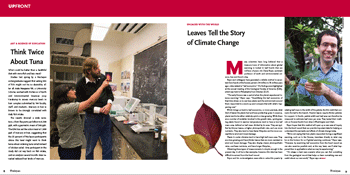Engaged With The World
 Many scientists have long believed that a treasure trove of information about global warming is locked in leaf fossils that are millions of years old. Dana Royer, assistant professor of earth and environmental science, has just found a key.
Many scientists have long believed that a treasure trove of information about global warming is locked in leaf fossils that are millions of years old. Dana Royer, assistant professor of earth and environmental science, has just found a key.
Royer and colleagues have generated a reliable method to ascertain from fossils of the Eocene period—34 million to 56 million years ago—data related to “leaf economics.” His findings were highlighted at the annual meeting of the Geological Society of America (GSA), which was held in Philadelphia from October 22–25.
“The early Eocene was a period when the planet experienced intense warming,” Royer says. “Quantifying the leaf economics of that time allows us to see how plants and the environment around them responded to a warm-up and compare that with what’s happening now.”
Which brings us back to leaf economics, or more precisely, what kind of leaves the plants had and how quickly they grew. In essence, plants tend to be either relatively quick or slow growing. While there are a number of variables involved in the growth rates, quick-growing plants found in warmer temperatures tend to have a low leaf mass area, defined as leaf mass divided by its area. They are typified by thinner leaves, a higher photosynthetic rate, and use more nutrients. They also tend to have faster lifecycles and be more susceptible to wind and insect damage.
Plants in cooler climates tend to have high leaf mass area. They are slow-growing and have thicker leaves that are more resistant to wind and insect damage. They also display slower photosynthetic rates, use fewer nutrients, and have longer lifecycles.
Obtaining these types of measurements is simple enough in the present day. In all but a few examples, however, this data has been difficult to extract from the fossil record.
Royer and his co-investigators were able to solve this puzzle by relating leaf mass to the width of the petiole, the thin stalk that connects the leaf to the branch. Heavier leaves require thicker petioles for support. In fossils, petiole width and leaf area can therefore be measured to estimate leaf mass per area. They tested their methods on Eocene fossils from sites in Washington and Utah.
Royer hopes that this method will open up a new area of inquiry into the fossil record that can provide important data for helping us understand the earmarks and effects of climate change today.
“We’re not saying that how plants responded during a significant warming, such as in the Eocene, translates directly to what may be on the horizon for us if global warming continues,” Royer says. “However, by examining leaf economics from the fossil record we can also examine parallels and, at the very least, see if what happened then is applicable to what we may be experiencing.”
“It’s always a best case scenario when you can find something from the geological record that helps us learn something new and useful about our own world,” Royer says.
